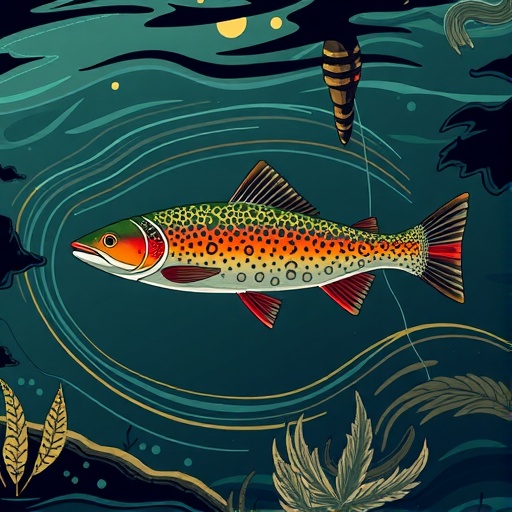In the heart of Northeast India, a study has emerged that could redefine our understanding of freshwater ecosystem health. Researchers have turned their attention to small indigenous cyprinids, a group of fish that often go unnoticed yet play a pivotal role in the ecological balance of rivers. Specifically, the Gumti River has become the focal point for this exploration of fish as bioindicators of environmental conditions. The importance of aquatic biodiversity cannot be overstated; it is essential for the sustainability of our water systems and overall ecosystem health.
Bioindicators are species whose presence, absence, or abundance reflects the health of their environment. In this context, small cyprinids serve as sensitive indicators, providing valuable insights into the myriad physicochemical attributes of freshwater habitats. The research documented in the study demonstrates a robust methodology in assessing how these fish respond to varying levels of pollutants and habitat alterations. The intricate relationship between fish populations and water quality underscores the need for comprehensive monitoring programs that can utilize these biological metrics effectively.
One of the key findings from the assessment indicates that changes in cyprinid populations can signal shifts in water quality. The study highlights how these small fish respond to factors such as nutrient loading, sedimentation, and the introduction of harmful substances. For instance, a decline in cyprinid numbers could indicate increased pollution levels, prompting immediate attention to water management practices. This relationship is crucial, as timely interventions can play a vital role in preventing long-term ecological damage.
Research conducted along the Gumti River involved extensive fieldwork, including river sampling and analysis of fish populations. The methodology applied combines traditional ecological assessment techniques with advanced statistical modeling to analyze the data effectively. By doing so, researchers were able to create a comprehensive profile of the health of the aquatic ecosystem based on the abundance and diversity of cyprinid species present. The nuanced understanding gained through this assessment emphasizes the necessity for integrating biological indicators in regular environmental monitoring.
The implications of this research extend beyond academic circles into the realm of practical environmental management. Authorities responsible for protecting water bodies can utilize such studies to inform conservation strategies. By focusing on small fish species like indigenous cyprinids, policymakers can create more targeted and effective regulations to mitigate human impacts on aquatic ecosystems. Such actions include restricting water pollutants and improving waste management practices alongside habitat restoration efforts.
Moreover, the study delves into the evolutionary aspects of these fish types, highlighting how they have adapted to varying freshwater conditions over millennia. Such adaptations make them not only resilient but also critical to understanding ecological balances. Their ecological roles—ranging from nutrient cycling to serving as prey for larger predator species—illustrate how their decline could have far-reaching consequences within the aquatic food web.
The notion that upstream activities—such as agriculture, urbanization, and industrial operations—can influence downstream ecosystems is well-documented. However, this research makes it patent that even small alterations to the environment can lead to significant biological responses. It emphasizes the fragility of these ecosystems and the crucial need for vigilant monitoring. The Gumti River serves as an essential case study, wherein localized strategies can be piloted and assessed effectively for broader application.
As environmental concerns become increasingly pressing in the context of climate change, studies like this provide a beacon of hope. They underscore the necessity for preserving biodiversity and maintaining the integrity of freshwater ecosystems. Not only do these ecosystems serve a multitude of services, but they also represent the lifeblood for many communities that rely on them for sustenance and economic stability.
The collaborative aspects of the research also highlight the vital role that local communities play in conservation efforts. Engaging with indigenous knowledge and traditional ecological practices can enhance scientific understanding and foster stewardship of water resources. Local involvement can act as a catalyst for broader conservation initiatives, encouraging sustainable practices that benefit both the environment and the people who depend on it.
As the academic community continues to explore the intersections of ecology, environmental science, and community engagement, the findings from the Gumti River research may inspire similar studies globally. The adaptability of small cyprinids as bioindicators can catalyze movements towards more ecological sensitive practices regarding freshwater ecosystems across diverse geographical contexts.
Ultimately, as environmental degradation continues to challenge global communities, the insights derived from this research raise a clarion call for proactive measures in ecosystem monitoring and management. By protecting small indigenous cyprinids and the habitats they represent, crucial steps can be taken toward ensuring the health of freshwater ecosystems for generations to come.
In conclusion, this in-depth exploration into the role of small cyprinids as bioindicators offers rigorous scientific evidence that can empower both policymakers and citizens. As the research community builds upon these findings, the hope is that greater awareness of freshwater ecosystem dynamics will inspire action at multiple levels—local, national, and international—to safeguard our precious aquatic resources for the future. It serves as a reminder that even the smallest creatures can provide critical insights and that their preservation is integral to the health of our planet’s ecosystems.
Subject of Research: Freshwater Ecosystem Health Monitoring
Article Title: Small indigenous cyprinids as bioindicators of freshwater ecosystem health: a comprehensive monitoring assessment from the Gumti River, Northeast India.
Article References:
Debnath, C. Small indigenous cyprinids as bioindicators of freshwater ecosystem health: a comprehensive monitoring assessment from the Gumti River, Northeast India. Environ Monit Assess 197, 1037 (2025). https://doi.org/10.1007/s10661-025-14508-2
Image Credits: AI Generated
DOI: 10.1007/s10661-025-14508-2
Keywords: freshwater ecosystems, bioindicators, cyprinids, environmental monitoring, Gumti River, ecological health, biodiversity, pollution, conservation strategies.




